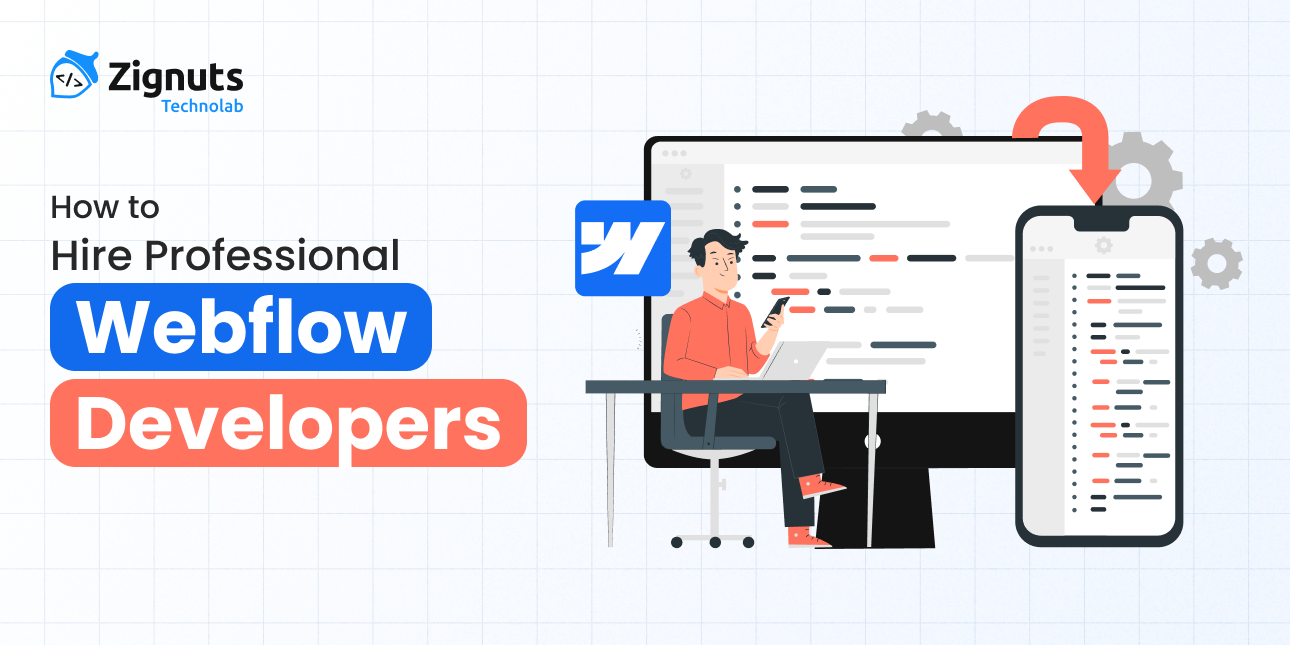In today’s competitive digital landscape, having a dynamic, visually appealing, and user-friendly website is essential. Webflow has rapidly become a preferred platform for building responsive, customizable websites without compromising on design or performance. However, to truly unlock Webflow’s potential, hiring professional Webflow developers is crucial. This comprehensive guide walks you through everything you need to know about hiring expert Webflow developers, why Zignuts is your ideal partner, and how to make your project a success.
Why Hire Professional Webflow Developers?
Webflow developers combine design prowess with technical skills to build websites that are not only beautiful but also scalable and optimized. They understand the intricacies of Webflow’s Designer, CMS, interactions, and integrations, enabling bespoke website experiences tailored to your business. Hiring professionals ensures:
- Seamless, pixel-perfect responsive design
- Fastload, SEO-optimized pages
- Custom animations and interactions
- Easy content management with CMS
- Smooth third-party tool integration
Defining Your Project Needs
Before beginning the hiring process, clearly define your project’s scope:
- What type of site do you need? (e.g., portfolio, e-commerce, SaaS landing page)
- Desired design complexity and interactive features
- Integration needs with third-party APIs or marketing tools
- Project timeline and budget constraints
A crystal-clear project brief helps attract developers with the right skill set and clarifies expectations upfront.
Where to Find Top Webflow Developers
Finding skilled Webflow developers requires exploring multiple talent sources:
- Freelance platforms: Upwork, Toptal, Fiverr, with skilled Webflow experts and reviews
- Webflow Experts Directory: Official Webflow partner listing with certified developers and agencies
- Professional networks: LinkedIn, Behance, showcasing portfolios and client feedback
- Referrals and agencies: Trusted recommendations and firms like Zignuts with dedicated full-time teams
- When assessing candidates for professional Webflow developer roles, it’s important to look for deep expertise and skills across several essential areas to ensure they deliver high-quality, scalable, and visually stunning websites. Below is an in-depth elaboration of key skills to evaluate:
Deep Expertise in Webflow Designer and CMS Functionality
A skilled Webflow developer must master the Webflow Designer toolkit, which provides full control over layout, typography, styles, and responsive design, all without writing code. This includes proficiency in CSS Grid, Flexbox, and positioning to craft pixel-perfect, adaptive interfaces. They should also have extensive experience with Webflow CMS — a robust content management system that allows dynamic, scalable content modeling using Collections, customizable fields, and template pages for automatic content rendering. Expertise in CMS API usage and workflow management is an added advantage, enabling integration with automated content pipelines and collaborative editing capabilities.
Strong Portfolio Demonstrating Visually Impressive, Responsive Designs
Candidates should present a diverse portfolio showcasing websites that are both aesthetically polished and functional on all device types. Look for clean layouts, balanced typography, effective use of white space, and the ability to convey brand identity through design. Responsive design must not only function but also maintain visual consistency and usability across desktops, tablets, and smartphones.
Knowledge of Custom Code Embedding for Advanced Needs (JavaScript, CSS)
While Webflow is primarily a no-code platform, advanced projects often require embedded custom code to extend functionality. Proficiency in writing and integrating JavaScript, custom CSS, and HTML embeds allows developers to implement unique interactive features, third-party plugins, custom animations, and complex integrations not natively supported by Webflow. The ability to debug and maintain these scripts within Webflow’s environment is critical for delivering tailored experiences.
Experience with SEO Best Practices Tailored for Webflow
A professional Webflow developer understands SEO fundamentals and implements them effectively within Webflow’s framework. This includes semantic HTML structure, clean URLs, meta tags, alt text for images, sitemap generation, and efficient loading times. Knowledge of how to use Webflow’s SEO settings per page and collection items ensures that websites rank well on search engines without compromising design or speed.
Ability to Implement Animations and User Interactions
Modern websites benefit from engaging animations and interactions that enhance user experience. Developers should be able to use Webflow’s visual interaction tools to create hover effects, scroll animations, page transitions, and click-triggered animations. Mastery in these helps build immersive stories and guides visitors intuitively, improving engagement and conversion rates.
Familiarity with Integrations (Zapier, Analytics, Marketing Tools)
Webflow websites often need to connect with external tools for marketing automation, analytics, and customer engagement. Candidates should know how to integrate apps like Google Analytics, Facebook Pixel, Mailchimp, and Zapier to automate workflows like form submissions, lead capture, and email marketing. Effective integration skills help businesses leverage data and optimize their digital presence.
Solid Communication Skills for Effective Remote Collaboration
Since many Webflow developer roles are remote, excellent communication skills are essential. Developers must clearly articulate progress, challenges, and technical concepts to stakeholders who may not be technical. Proficiency in collaborative tools (Slack, Zoom, project management software) and responsiveness fosters smooth teamwork, ensuring project objectives are met on time and changes are efficiently managed.
The Hiring Process: Step-by-Step
- Job Description: Create a detailed description outlining project scope, technical and soft skills needed, remote work expectations, and timelines.
- Candidate Sourcing: Use platforms, directories, and referrals to find candidates.
- Screening: Review portfolios, perform resume screening, and conduct background/reference checks.
- Technical Assessment: Conduct live tests or assign a relevant project to evaluate practical capabilities and problem-solving.
- Interview: Discuss experience, project approach, communication style, availability, and cultural fit.
- Offer & Contract: Present a clear contract including scope, timelines, confidentiality, and IP rights.
- Onboarding: Provide project brief, access to tools (Webflow, Slack, Zoom), assign mentor/PM, and set communication norms.
Managing Your Webflow Developers Effectively
- Use project management tools like Jira, Trello, or Asana.
- Maintain regular check-ins via video calls.
- Set clear milestones and review deliverables diligently.
- Encourage open feedback and continuous learning.
- Foster a collaborative culture even in remote setups.
Why Choose Zignuts for Hiring Webflow Developers?
Zignuts simplifies your hiring journey with a proven 4-step hiring process and expert full-time Webflow teams:
- Vetted, skilled Webflow developers with extensive portfolios.
- Agile development is aligned with your project goals.
- Seamless communication with daily updates.
- Flexible engagement models fitting your budget and timeline.
- Ongoing support, quality assurance, and transparent workflows.
Zignuts’ commitment to quality and a client-centric approach ensures your Webflow project succeeds without hassles.
Conclusion
Hiring a professional Webflow developer empowers you to create visually stunning, high-performing websites tailored precisely to your business needs. From defining project requirements to sourcing, assessing, and managing talent, a strategic approach is key. By partnering with Zignuts, you access a dedicated team that delivers quality, efficiency, and innovation, ensuring your Webflow projects thrive.




.svg)

.svg)



.svg)

.svg)


.png)





.png)
.png)
.png)
.png)
.png)
.png)
.png)
.png)
.png)



